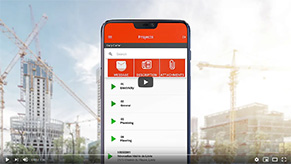
2 February, 2023
Mobile-Punch
SHARE
What is a construction punch list?
Construction projects are complex endeavors that involve many different tasks and components. Ensuring that all of these tasks are completed to a high standard is essential for the success of the project. One tool that is commonly used to help manage this process is the construction punch list.
In this article, we take a closer look at what a construction punch list is and how it is used. We also explore the benefits of using a punch list and the role it plays in the overall project management process. Whether you are a contractor, project manager, or owner, understanding how to use a construction punch list can help you ensure the success of your construction projects.
What is a construction punch list?
A construction punch list is a document or checklist that outlines the items that need to be completed or corrected in a construction project before it can be considered complete. It is typically used to identify any deficiencies or incomplete work that needs to be addressed before the project can be considered finished.
In general, punch lists are often used as a tool for quality control and to ensure that all parties involved in the project are aware of the work that needs to be done. They are usually compiled by the contractor or project manager and may be reviewed and approved by the owner or other stakeholders.
What is a “zero punch list” in construction?
A zero punch list in construction refers to a project that has no outstanding items on the punch list, meaning that all tasks and issues have been completed and addressed. In other words, a zero punch list means that the project is complete and ready for final inspection and acceptance.
Achieving a zero punch list is the ultimate goal of any construction project as it indicates that all work has been completed to the specified standards and that the project is ready to be handed over to the owner or occupants. To reach this goal on a construction project, all problems and unfinished work must be found and fixed. All materials must also be installed correctly and checked for quality.
The process of achieving a zero punch list typically involves reviewing the punch list with the contractor or project manager, identifying all outstanding items, and resolving them. This could mean fixing things, putting in missing parts, or taking care of any other problems that need to be addressed before the project can be declared complete.
Getting to the end of a punch list requires careful planning and attention to detail, as well as effective communication and collaboration among all parties involved in the project. If you follow a thorough and organized process, you can make sure that all the tasks are done well and that the project is ready for final inspection and approval.
How to reduce costs in a construction project
What are punch lists used for?
Punch lists are typically used as a quality control tool. On construction projects, punch lists may also be used to track the progress of a project and identify any areas that need additional attention or resources.
What items does a punch list include?
A punch list may include a wide range of items, depending on the specific needs of the project. Some common items that may be included in a punch list include:
- Unfinished or faulty installations;
- Missing materials;
- incorrectly installed materials or systems;
- Defective or damaged items;
- Non-compliant work;
- Any other issue that needs to be resolved before the project can be considered complete.
When are punch lists typically executed?
Punch lists are typically executed at the end of a construction project, when all the work has been completed. However, they may also be used at intermediate stages of the project to identify and address any issues that may arise. For example, they may be used after the completion of each phase of the project, or after the installation of a specific system or component.
On the other hand, some projects use a “rolling punch list” in which items are added to the list as they arise and addressed on an ongoing basis. This method can help make sure that problems are identified and fixed quickly, preventing delays or expensive rework in the future.
Who is responsible for creating and managing a punch list?
The responsibility for creating and managing a punch list typically falls to the contractor or site manager. However, the owner or other stakeholders may also be involved in reviewing and approving it. In some cases, an independent third party, such as a quality control inspector or an engineering firm, may be responsible for creating and managing the punch list. The specific roles and responsibilities of each party will depend on the terms of the contract, and the requirements of the project.
Best timesheet app for construction companies
The punch list process
Curious about the punch list process? Here’s a quick overview of what it typically involves.
Identify outstanding items
The first step in the punch list process is to identify any outstanding items that need to be addressed. This may involve reviewing the work that has been completed and identifying issues or deficiencies that need to be resolved. There may be installations that aren’t finished or aren’t working right, materials that are missing, or other problems that need to be fixed before the project can be declared complete.
Create the punch list
Once all outstanding items have been identified, the next step is to create the punch list. The punch list should be a comprehensive and detailed list of all tasks and issues that need to be resolved. It should have clear, detailed explanations of each item, as well as other important information, like location, scope, or priority.
Review and approve the punch list
Once the punch list has been created, it should be reviewed and approved by the appropriate parties. This may include the contractor, site manager, owner, other stakeholders, and relevant regulatory agencies. The review and approval process is an important step in ensuring that all parties are aware of the work that needs to be done and that the punch list accurately reflects the status of the project.
Complete the tasks on the punch list
Once the punch list has been reviewed and approved, the next step is to complete the tasks that it contains. Common punch list items may involve making repairs, installing missing materials, and addressing flaws or problems that need to be resolved. In general, it is important to prioritize tasks based on their importance and impact on the project, and to allocate resources and personnel accordingly.
Verify completion
The final step in the punch list process is to verify that all tasks have been completed and that the project is ready for final inspection and acceptance. This may involve reviewing the punch list with the contractor or site manager, conducting inspections or tests, and verifying that all work has been completed to the specified standards. Once all tasks have been completed and verified, the project can be considered complete, and the punch list for construction can be closed.
5 ways to reduce your administrative tasks
Best practices for construction punch lists and how to improve the process
Clearly define the scope of work
To ensure the success of a construction punch list, you need to have a clear and accurate understanding of the scope of the work involved. This includes identifying all tasks and materials that need to be completed, and making sure that all parties involved in the project have a clear understanding of their responsibilities and can bring your project to completion.
By clearly defining the scope of work, it is easier to identify and address any issues or deficiencies that may arise, and to ensure that the project is completed to the specified standards.
Use a standardized format and terminology
There are many construction punch list templates that you can use. Using a standardized format and terminology for your punch list can help ensure that all parties involved in the project are on the same page, and can easily understand and track the status of the project.
This may include using a standardized template for the punch list, as well as consistent and clear language to describe each task or issue. Alternatively, you can use a project management tool to develop a punch list management format that’s standardized, track progress on individual tasks, and collaborate with other parties involved in the construction process.
Regularly review and update the punch list
It is important to regularly review and update the punch list checklist to ensure that it accurately reflects the status of the project. This may involve adding new tasks or issues as they arise, as well as marking off tasks that have been completed. By keeping the punch list up-to-date, it is easier to track the progress of the project, and identify areas that need additional attention or resources.
Communicate effectively with all parties involved
Effective communication is key to the success of any construction project, and the punch list process is no exception. It is important to ensure that all parties involved in the project are aware of the tasks and issues that need to be addressed, and have a clear understanding of their responsibilities. This may involve regularly reviewing the project punch list with the team, providing updates and progress reports, and communicating changes or updates to the construction project plan.
Use technology to streamline the process
There are a number of technological tools and apps that can help streamline the punch list process, and improve the overall efficiency of your operations. Project management software or collaboration platforms can improve communication and coordination among team members.
How mobile apps are helping businesses recover post-covid
Save time and money with Mobile-Punch
Are you looking to improve your business with a construction punch list software? Mobile-Punch is the perfect solution. It’s an easy-to-use digital platform that helps you create and manage accurate, up-to-date contractor punch lists for all of your construction projects. With its intuitive interface and real-time updates, it makes it easier than ever to keep track of tasks and issues, communicate with team members, and ensure that all the work is completed to the specified standards.
Mobile-Punch can save you time and money by streamlining the punch list process from start to finish. You’ll be able to quickly identify areas that need additional attention or resources, and get back on track faster without sacrificing construction quality or accuracy.
Here are key features of our digital app:








